Table of Contents
Dentists use intraoral scanners to capture optical impressions of the dental arches’ soft and hard tissues and digitally transfer them to an interface, lab, or computer monitor for printout and interpretation. If you have visited a dentist recently, you must have encountered this small wand-like device that provides dentition information on the fly.
The field of dentistry has grown in leaps and bounds, from the use of dental impressions to the now sophisticated intraoral scanners. The latter, however, has been around for quite a while and has undergone significant innovations over the years to make them more sophisticated to carry out more complicated functions. Some have been made more portable, while others can detect dental infections by scanning the dentition.
The devices don’t come cheap, and due to constant innovation, dentists sometimes put their intraoral scanners for sale to invest in the new advanced devices for their clinics. Retail stores also put intraoral scanners for sale, mainly because of advancements in technology. In the excerpt below, we will discuss some of the best intraoral scanners in dentistry and share information on comparing the intraoral scanners.
In digital dentistry, using digital impressions is shaping the way dentists work. Indeed, they are a way of delivering precise services to patients. Intraoral scanners in dentistry are a vital necessity in making dental impressions. That’s why these scanners are now indispensable to any prosthodontist. They make his service delivery seamless.
But how well do you understand how intraoral scanners for dentists operate? How about their benefits or shortcomings? Well, in this quick guide, we’ll provide you with an in-depth view of the use of these scanners in modern-day dentistry. Their superior quality is worth examining. Let’s get to it!
What Are Dental Impressions?
Dental impressions are 3-D intraoral scans. Here, the dentist makes a digital replica of the mouth. He uses a scanner, a computer, and CAD/CAM software to generate a virtual model of the mouth. Indeed, this model will show all the hard and soft tissues in and around the gums. Typical dental impressions cover surgical templates, custom devices, prosthetic restorations, and orthodontic aligners.
Accurate impressions help prepare speedy and reliable bridges, dentures, retainers, and crowns. Then, the dentists use the models to provide an effective treatment plan for patients. Now, an efficient dental impression needs a reliable scanner. That’s why most dentists opt to use intraoral scanners.
What are Intraoral Scanners in Dentistry?
 Intraoral scanners are tools used to produce direct optical impressions. They do this by scanning the region of the mouth in question using a laser projection. The images from the scans go through scanning software to make point clouds. That is, the software converts these images into 3D surface models. These models replace the traditional plaster molds from analog impressions.
Intraoral scanners are tools used to produce direct optical impressions. They do this by scanning the region of the mouth in question using a laser projection. The images from the scans go through scanning software to make point clouds. That is, the software converts these images into 3D surface models. These models replace the traditional plaster molds from analog impressions.
How Do Intraoral Scanners Work?
A typical Intraoral scanner uses a camera for the input. Also, it has a computer as the monitor for the output and software to process the output images. The scanner generates a 3-D record of the image and keeps it in either the open STL or the locked STL-like format. Both formats have widespread industrial applications. Still, they only point out the model in a triangulated way.
Now, we have some of the latest formats, like the PLY files and the Polygon file formats. They capture the object’s texture, color, and transparency. This progress means that we now have more precise outputs.
Reasons to Integrate Dental Clinics with Intraoral Scanners
-
Accurate Input Data, Minimal Human Errors
Many studies show that intraoral scanning results in more accurate procedures. The primary source of error in any dental procedure arises from how the raw data or models are extracted. Hence, by letting science do the job, human error is no longer a factor to reckon with.
-
Improve Patient Comfort
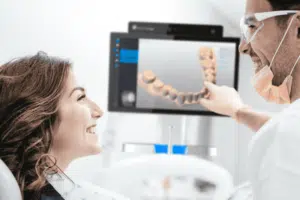
Analog impressions need to get images of the patient’s mouth using conventional methods. Some of these techniques felt awkward for the patients. For example, the dentist would insert an impression tray in the patient’s mouth for a long. Not all patients could endure an uneasy posture.
In the process, they had a gag reflex. Other discomforts with analog dental impressions include a bitter taste and breathing impairment. Some patients complained about tooth sensitivity, smell or voice, and TMJ discomfort. With time, other patients would avoid seeking the necessary vital treatments.
Intraoral scanners get rid of such conventional styles and their setbacks. In particular, IOS does away with scans using CBCT and plaster models. In turn, they cut the chances of patients’ discomfort. Intraoral scanners in dentistry use optical prints to create scans and virtual models.
-
Time Efficiency
Intraoral scanners involve few, if any, physical tasks. So, they take a fraction of the working time needed for conventional impressions. For example, such scanners can achieve a full arch scan in less than 3 minutes. After the scan is complete, there is no need to use stone casts or plaster models. Instead, the dentist sends the STL files to the laboratory via email. Hence, even the logistics of courier services are nonexistent.
Even so, what happens when a patient requires chair-side prosthetic restorations? Here, the dentist will import the optical impressions into CAD software. He’ll come up with a suitable design for the restorations. Then, the data is again sent to CAM software, which goes into a milling machine. The final result is patient-ready restorations that are accurate and timely. All in all, the real-time saving is after the scan. All the physical steps associated with analog dental impressions no longer exist.
-
Easier Work Processes for Clinicians
Like any other digital tool, intraoral scanners in dentistry make clinicians’ work easier, for they can handle even the most complex cases straightforwardly. So, what happens when the clinician needs to generate many implants? Or could you perform a tough undercut? He can identify each implant of the undercut with precision.
Such procedures would otherwise prove difficult when dealing with conventional impressions. What if the clinician wants to revise the scans? He can delete them and start over without asking the client to undergo another scan. Indeed, the procedures become simple for both the patient and the doctor.
-
Gets Rid Of Plaster Casts
As noted, digital impressions ensure that most, if not all, of the physical procedures after the scan. The clinician does not need to prepare any plaster casting after the scan. Now, this change is time-saving and cheap. For, intraoral scanners eliminate the costs of dental consumables to make the casting. In turn, digital impressions become an affordable option for the patient.
-
Real-Time Analysis, Easier Communication for Clinicians
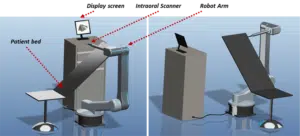
Digital impressions can run on the current hospital software management system. In effect, the clinicians can send and receive real-time feedback. It goes to the laboratory, nurses, and patients smoothly and smoothly.
The patient gets real-time updates about his treatment. He’ll know what to expect in the next appointment. The clinician may show the patient a 3D view of what he should expect at the end of the procedure.
The patient may suggest what he wants to change or revise. Again, the patient does not have to return and repeat the scans. This better communication builds trust between the clinician, his team, and patients.
-
Better Marketing for The Dentist’s Practice
Better patient-dentist communication creates an avenue for the dentist to market his services. The patient knows that the dentist is caring and reliable. Hence, he will recommend these services to friends and family who need the treatment. If a procedure is impossible, the patient may request referrals at the dentist’s clinic. Here, the dentist cross-sells the services of other practitioners to perform the treatment. So, IOS is an indispensable marketing tool whose results speak for them.
-
Increased Patient Numbers, Cut on Related Costs
Intraoral dental scanners reduce the working times before and after the scan, meaning the dentist can see more patients daily. This increase in visits will convert to better turnover without compromising service delivery.
The removal of expensive consumables means the sales margins will also improve. The dentist sends the files to the laboratory via email. Hence, there is no need for courier and storage services. Finally, orthodontists can keep the virtual models for eternity. Here, they’ll refer to them for as long as they want. This improvement is a plus. For conventional impressions, generate models that last up to five years.
Challenges of Using Intraoral Scanners for Dentists
-
Deep Marginal Lines Are Impossible to Detect on Prepared Teeth
Intraoral Scanners can’t detect deep-set marginal lines on the prepared teeth. More so if the patient has bleeding gums. Unless there are prosthetic margins, the light will not find the finishing line. Even so, the prosthetic margins can’t work on bleeding gums.
Intraoral Scanners in dentistry are visible for quite a short time before the blood from the bleeding gums obscures them. So, when the retraction cord is out, the gingival sulcus will close up. If an area is invisible to the eye, even if it exists on the physical, it will not show on the scans. This weakness does not exist in conventional impressions.
To counter this setback, practitioners need strategies to highlight the preparation line. These include using more than one approach. For example, they may insert a double retraction cord. At the same time, they support oral hygiene techniques that control too much bleeding. If need be, the dentist may have to use digital and analog impressions to counteract the setback.
Note that so much goes into preparing the digital impressions. It involves checking all these limits to gauge its suitability for the issue at hand. Hence, the dentist ought to be prudent in making the right choice for the patient’s interests.
-
A Significant Learning Curve
Dental practitioners need time to learn how IOS works. Then, they’ll be able to reap their full benefits. Still, the learning curve is rather fast for today’s dentists. Moreso, if he enjoys working with the latest innovations. Again, manufacturers make intraoral scanners with a variety of scanning strategies. Each brand is different. Hence choosing the ideal intraoral scanner for your practice is critical.
-
Significant Long Term Investment
High-end intraoral scanners retail at a rather hefty price. Plus, the relevant management systems to tap into the scanner’s full potential are a must. The dentist will recoup this initial cost during the equipment’s lifespan. Also, manufacturers ask for monthly or annual fees for support services. Hence, only a well-established dentist practice can withstand such an investment. Other clinics may struggle with extreme cash flow problems after the buy.
Current Clinical Applications of IOS
Below is a list of today’s clinical applications of intraoral scanners: –
1. Diagnostic Purposes
Intraoral scanners come in handy when identifying and making restorations. They help in creating custom units needed for surgery, prostheses, and orthodontics.
2. Dentist-Patient Communications
HMIS works with IOS skills to let patients know about their treatment in real-time.
3. Making Prostheses
Intraoral scanners help in coming up with prosthetic restorations. Other applications include zirconia copings, resin in-lays or on-lays, dentures, crowns, and ceramics.
4. Dental Implants
IOS generates optical impressions useful in making dental implants. These implants help in coming up with implant-supported bridges, bars, and crowns.
- Making digital smile design techniques
- Fabricating obturators
- Planning orthodontic diagnosis and treatment
Moving forward, the use of intraoral scanning and digital impressions in guided dental surgery is in its infancy stages.
Tips and Tricks for Using Intraoral Scanners
1. Preparation Is Key
As noted, the dentist can avoid most of the setbacks in digital impressions by prior planning. Prepare the patient for the procedure. Let them know what they should expect. Address any fears they may have.
2. Aim For a Dry Mouth Before The Scan is Conducted
Ask the patient to spit or swallow any saliva in the mouth. Or, blow some air onto the teeth. The dry teeth will help in capturing precise images.
3. Maintain a Clear Screen
Digital scanners are not immune to delays. More so, when relaying the captured scans to the computer. To prevent such mishaps, wipe the scanner’s screen about the finish of scanning the image.
4. Educate Your Future Patients Using Past Samples
One easy way for new patients to accept IOS is by proving to them that they work. And, there is no better proof than your past successes. Use your past triumphs to show the IOS prowess. Show your patients how efficient the intraoral scanners are in the dentistry profession.
Intraoral Scanners – Compare The Products
Now the above discussion is an in-depth appreciation of intraoral scanners. It also helps you see their relevance in modern dentistry. Then, what is the best intraoral scanner in 2020?
Here is a list of the top 10 intraoral scanners for a dentist you may want to try for practice:
1. CEREC Omnicam from Dentsply Sirona ($6,666.00)
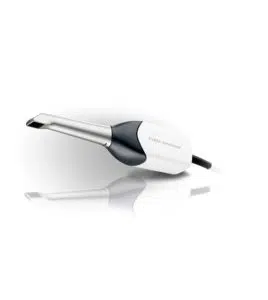
Nothing compares to the pain of a toothache in the middle of the night when you have little or no access to help. However, a visit to the dentist will reveal the source of the problem and how far it has spread in your dentition. A digital dental clinic will thus be able to provide you with a clear picture of what exactly is happening to your oral cavity.
And this will be achieved by using the Cerec Omicam. The latter is the latest oral scanning technology that provides doctors and patients with 3D dental images in natural color, complete with full arch scans. The scanner is light in weight on the doctor’s hand and comfortable when inserted in the patient’s mouth, a feature that has been facilitated by its slim design.
The images provided by the intraoral scanner enable the dentist to make a reliable diagnosis and conclusive report on the problem areas, thus offers a comprehensive treatment solution.
2. Carestream CS 3700 ($11,999.00)
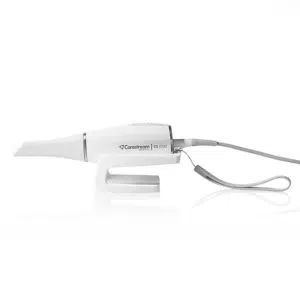
Compared to the Cerec Omnicam, the Carestream CS 3700 is highly priced but with many similar features, such as the ergonomic design and its ability to fit into the patient’s mouth without causing discomfort. A distinct and significant feature incorporated in this intraoral scanner (Carestream cs) is the wrist wrap that keeps the device safe at the doctor’s hand.
Other important features are that the Carestream Intra Oral scanner provides the doctor with a chance to pursue any indication from a single scan; practitioners can also access clean mesh details. Managing the collected information has been simplified because the scanners can send digital models to a lab or a third party with one click.
Users also interact with an intuitive interface that enables them to use the provided software via a seamless touch screen navigation. And while utilizing the Carestream intraoral scanner, users will also be treated to the latest software updates. The companies support ensures that users can access ongoing software and equipment support.
3. CEREC Primescan from Dentsply Sirona ($19,999.00)
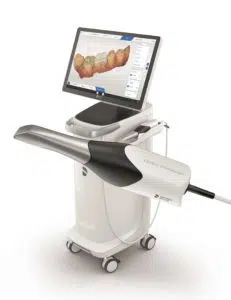
Cerec is determined to cater to all its user’s both high and low end from all indications. For the high-end practitioners who don’t want to miss the opportunity of bagging the top dollar, then the Cerec Primescan from Dentsply Sirona is your money maker. Matters money aside, the primescan does come with some pretty cool features that speak professionalism.
For example, the equipped smart pixel sensor can process over 1,000,000 3D points per second, thus providing doctors with photo-realistic and very accurate data from which accurate treatment decisions can be made.
What’s more, dentists using the primescan can interact with a dynamic depth scan technology that provides them with perfect sharpness and precision. The above also covers a measuring depth of 20mm, thus providing a clear vision for the deeper-lying indications.
Dentists also don’t have to constantly sweep an area for clarity because they are provided with an increased field of view that provides high precision even with fewer sweeps. The working speed of the primescan is quite impressive as it can consolidate over 50,000 images per second and process the exact data that the software needs.
Primescan turns out to be one of the best intraoral scanners. If you haven’t gotten one for your practice, you best put your current intraoral scanners for sale and adopt this time-efficient, accurate, and effective Cerec prime scan.
4. Medit i500 ($10,345.00)

Anytime you interact with the intraoral scanning devices, the price point always has a story to tell, and for the medit i500, it is a sweet, professional one. For starters, the scanner can create the perfect margin lines in case you need a prosthesis designed.
Even more interesting is that dentists can use the scanner to capture HD pictures that reveal the real situation of the teeth, thus giving them an upper hand in determining a patient’s problem. And in the long run, they can provide the patient with a clear picture of their situation, thus making them understand why the pending procedure has to be done.
Medit i500 enables dentists to perform pre-operational scans on their patient’s teeth, a technology that is not available on the other intraoral scanners that we have reviewed, including the high-end Cerec prime scan. The preoperational scan can be used to make the post-operation easy and quick; dentists can also use the acquired data as a blueprint to create natural prostheses.
5. iTero element 5d ($24,000.00)
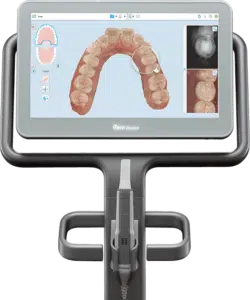
So this is why the iTero element intraoral scanner is so expensive; the device has the ability to scan the internal structure of a tooth and give you feedback in real-time. Manufacturers of the iTero element have incorporated the NIRI technology, a feature that makes it stand out from some of the best intraoral scanners because it can detect interproximal caries in its early stages.
And remember, for the above patients are not at risk of suffering from the radiation. The iTero element 5D scanner is also known to integrate the dental imaging system, which records NIRI, 3D, and Intracolor images, thus giving the users a chance to compare them over time via the itero time lapse.
A full arch scan using the iTero element 5D provides dentists with information on the 3D impressions necessary for orthodontic and restorative works. And for a summary of the patient’s progress, the iTero element has incorporated a time-lapse technology that lets the doctors compare their patient’s present-day scan and their historic 3D scan.
Information collected in the above comparison enables dentists to measure tooth wear, orthodontic movement, and gingival recession. The high price point of the iTero element has now been justified. However, we haven’t covered all of the significant features.
6. Dental Wings Virtuo Vivo ($19,999.00)

Dental wings virtual Vivo has not incorporated the sophisticated features. Still, with the above price, you will benefit from voice and gesture control, and you will also access a preconfigured system. The device offers basic dental digital services such as speed and accuracy in capturing the images, and it will then provide the dentists with life-like images.
Other important integrations are the streamlined workflow and the addition of new features by the company via the software updates to offer users a continued optimized experience. The Dental wings camera has incorporated advanced technology in the making of the scanner, whereby it has been equipped with 4 miniature cameras complete with one projector in the handpiece tip to enable easy scanning of the hard-to-reach areas but with less effort.
So in comparison with the above-reviewed scanners, dental wings stand out because of the cart solution, voice, and gesture control. But the scanning capabilities are still wanting given that some intraoral scanners can scan up to 20mm deep.
7. 3Shape TRIOS 4 ($8,888.00)
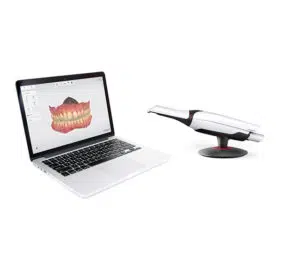
When we talk about innovation in dentistry, then the 3 shape Trios 4 is exactly what we are talking about. The price point is very manageable for dentists who want to take their practice to the next level with affordable but equally effective intraoral scanners.
The 3 shape Trios 4 scanner has been designed to detect the surface and interproximal carries without exposing the patient to danger via radiation. The incorporated instant heat smart tips help save power, and you can thus use the scanner on more patients without the battery necessarily dying out.
And for the feature that makes the scanner stand out is the ability to operate without the electrical wire cable, and remember that you do have the wired and wireless options with this intraoral scanner, so you might notice some difference in weight, especially when using batteries.
For more sophisticated operations, you might want to consider putting the 3shape trios scanner for sale and get one of the best intraoral scanners discussed above, like the Cerec prime scan that comes with advanced and effective functionalities.
8. 3M True Definition Scanner ($4,900.00)
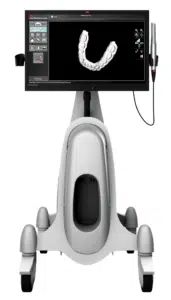
From the price point, we can say that this is not exactly high-end and only provides the basic services when taking digital optical images. The unit is comfortable and easy to handle. If you aim to woo clients by providing them with the most sophisticated and advanced technology in dental imagery, then it would be best if you considered one of the high-end options discussed above.
The expensive intraoral scanners aren’t costly, first because of their service, which gives the dentist the right to charge extra for the extra service. In short, there is no reason for not digitizing your practice, failure to which you fail to attract the big bucks.
9. CondorScan ($9,500.00)

The condor scanner seeks to define the phrase going digital practically; the fact that you can comfortably use it while connected to a laptop makes it a convenient tool for dental clinics that are slowly transitioning from analog to digital. Dental practitioners will perform the most relevant and necessary procedures but don’t expect the speeds to match the above-reviewed scanners.
However, if you love the condor brand and want to stick with it, you can invest in the advanced new 3.2 condor version faster and produces almost accurate images. What’s more, is that it can help dentists create amazing restorations. Given the fair price, the condor does come with some interesting and convenient features such as compactness, making it easy to work with.
The intraoral device doesn’t utilize powder to achieve digital impressions. It, however, comes with free ever updated software and will provide you with an ROI in less time. But, if you want the top dollar, then take your time and carry out an intraoral scanner comparison and settle with the one that has the highest ROI.
10. Planmeca Emerald S ($11,999.00)
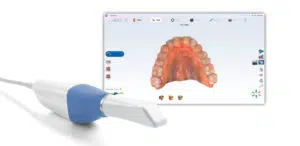
If you are all about diagnostic and usability, then the Planmeca Emerald will suffice for intraoral scanning. The high price point can be justified by the speed at which the planmeca intraoral scanner works while providing clear arch coverage.
The scanner’s slim design makes it convenient for the doctors to hold and easily use it on a patient’s mouth without getting fatigued. Upon purchase of the Planmeca Emerald, users will also be furnished with two extra tips. Sharing the patient’s data is also enabled in the planmeca; you can utilize both the PLY and STL file formats.
The Planmeca Emerald intraoral scanner retails at a rather high price with basic features, so by adding a few dollars, you will be able to get a highly functional and sophisticated intraoral scanner to help digitize your clinic.
Conclusion
Digital impressions and the use of intraoral scanners are revolutionizing the dental profession. It’s a plus for the patient who wants the best treatment and the practitioner who wants to maximize his skills. Hence, it’s a welcome approach for any dental clinic. We hope you can use this in-depth guide as an eye-opener to limitless opportunities.
The above discussed intraoral scanners have all incorporated unique features to offer a competitive edge; we do have some of the best scanners that come with a steep price and some of the fairly priced intraoral scanners for sale so that you can upgrade to the more digitized options that promise a good ROI. However, they are all the best intraoral scanners that will suffice the various needs of different dental practitioners.
